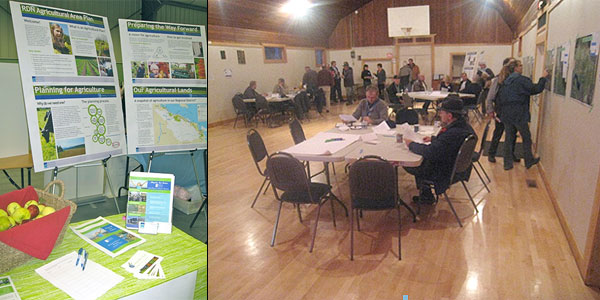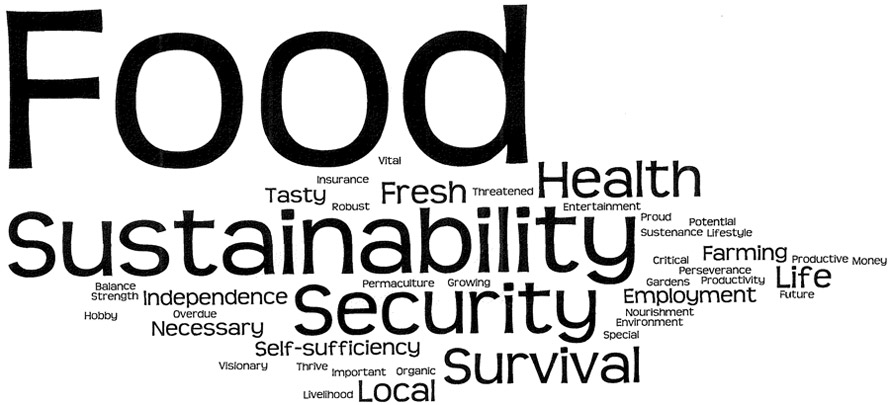Agricultural Area Plan

Welcome! Thank you for your interest in our Agricultural Area Plan. The plan process was initiated in early 2011 by the Regional District of Nanaimo (RDN) to support, preserve, and enhance viable agriculture and food production in the Nanaimo region. This initiative was rooted in community engagement with extensive input from the local agricultural and aquaculture communities and people who are interested in local food - whether growing it, preparing it, selling it or eating it! The purpose of the planning process was to enable local government, citizens, stakeholders and food producers to work together to articulate a shared vision for the future of agriculture and aquaculture in the region and the steps needed to achieve this vision.
We are pleased to announce that the Plan was adopted by the RDN Board on October 23, 2012. We encourage everyone to read the Adopted Plan and revisit this site for more information as we move forward with Plan implementation.
What is an Agricultural Area Plan?
An Agricultural Area Plan (AAP) is a strategy and policy framework to guide ongoing agricultural-related decision making within the Regional District of Nanaimo. The Plan is intended to inform RDN bylaws and policies, which aim to support local agriculture and aquaculture as viable and sustainable economic sectors which are integral to the regional landscape. The Plan also identifies many other key players that will be instrumental in achieving the goals of the Plan, including member municipalities, other government agencies, community groups, farm operators, etc. The Plan recommendations are intended to guide the efforts of these key players and ensure that collectively they work towards the Plan goals concerning agriculture and aquaculture throughout the Nanaimo region.
Where are we at in the Plan Process?
The planning process was completed on October 23, 2012 with the adoption of the "Growing Our Future Together – Regional District of Nanaimo Agricultural Area Plan". This process involved multiple stages of policy research, community dialogue, land use analysis, statistical reviews, and the formulation of recommendations and an implementation strategy. To review additional background information and RDN staff reports related to this project, and to view engaging YouTube videos of local 'Agriculture in Action', please Click Here.

Agricultural Area Plan Goals
The RDN Agricultural Area Plan contains eight key goals, which are based on extensive community engagement:
- Protect and Enhance the Agricultural Land Base in the RDN
- Strengthen the Local Agriculture and Aquaculture Economy
- Improve Training, Skills, and Labour Opportunities in the RDN
- Improve Opportunities for On-Farm Water Resource Management
- Address Environmental Sustainability, Wildlife, and Climate Change Challenges in the RDN
- Promote Awareness and Value of Local Agriculture and Aquaculture
- Support Agriculture and Aquaculture in Land Use Regulations and Policies
- Consider Agriculture in Emergency Planning Initiatives
Community Engagement
The RDN has worked collaboratively with the project consultant, local community stakeholders, farmers and citizens to complete extensive community engagement. Public open houses, round table dialogues, and focus group workshops were held throughout the region in 2011 and 2012, with additional information-sharing and interviews with growers, retailers, chefs, educators, and many others interested in local agriculture!

Photos: (Left) RDN information table at Coombs Fair; (Right) Public open house in Errington
An online public survey was also posted from May 15th to June 15th, 2012 to seek further comments on the Draft Plan goals and objectives, vision statement, and potential key players and funding agencies that could support the plan implementation. A total of 112 people participated in the survey; the majority of respondents (87%) supported the Plan goals and objectives, and some individuals provided additional comments about ways to support local agriculture and aquaculture. Overall, there was a collective desire to see the Plan implemented and more food grown locally.
One of the survey questions asked participants to describe, in one word, what agriculture in the Nanaimo region means to them. The five most frequently cited words were: food, sustainability, security, health and survival. The word collage below illustrates the responses –the more often a word was stated the greater the visual prominence in the collage.

Project Timeline
| Summer 2011 | Background information collection Land Use Study of Agricultural Activities Community Outreach (Coombs Fair, VIEx) |
| Fall 2011 | Create Agricultural Profile Focus Group Sessions / Community Engagement |
| Winter 2012 | Technical Analysis / Background Report Focus Group Sessions |
| Spring 2012 | Draft the Plan Community Review of the Draft Plan Revisions to Plan |
| Summer 2012 | Agricultural Area Plan Adopted |
How to Get Involved
We would like to thank everyone who has participated in the conversation about agriculture in our region though this web site, online survey, open houses, round-table dialogues, focus group workshops, 'Agriculture in Action' documentary YouTube videos, and information-sharing with others about this community-initiated project. We encourage you to read the Adopted Plan, consider your role in taking action as an individual or within a community group, and revisit this site for more information as we move forward with implementation with direction from the RDN Board.This project was funded in part by the Investment Agriculture Foundation of B.C. through programs it delivers on behalf of Agriculture and Agri-food Canada and the B.C. Ministry of Agriculture.
Funding Provided By:
Agricultural Area Plan Implementation
Now that the Agricultural Area Plan is complete the RDN is considering implementation of the Plan's goals and policies. On November 26, 2013 the Regional District of Nanaimo Board received the 2014 - 2016 Agricultural Area Plan Action Plan. The Action Plan addresses 40 out of 68 priority action items identified by the Agricultural Advisory Committee and prioritizes them for implementation between 2014 and 2016. The 40 action items are grouped into 6 projects in the Action Plan to be undertaken during this period. Read the Action Plan for more information on these projects. Please continue to check the website for updates as we move forward with the projects identified in the Action Plan.


